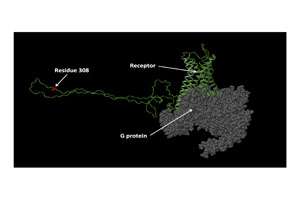Team constructs model of receptor protein linked to human growth

A study published in the New England Journal of Medicine reveals the role of a receptor protein derived from a gene that has been linked to human growth. Co-author Stefano Costanzi, Ph.D., an assistant professor of biochemistry at American University, developed the three-dimensional computer model of the receptor that appears in the study.
"As the study reveals the receptor's role in growth, it may ultimately lead to the development of drugs to treat those affected with conditions that alter growth, such as gigantism or dwarfism," Costanzi said. "The construction of the model is an initial step in that direction. We are well-positioned to identify molecules that can activate or block the receptor, which is how a drug discovery endeavor starts."
The work was led by researchers at the Eunice Kennedy Shriver National Institute of Child Health & Human Development (NICHD) of the National Institutes of Health (NIH), under Scientific Director Constantine Stratakis, M.D., D.Sc., the lead investigator and the study's senior author, and involved a total of 51 authors from the United States, Belgium, France, India, Canada, Italy, Russia, the United Kingdom and Australia.
Their investigation led to the discovery of a receptor linked to gigantism in children and acromegaly in adults, a rare disorder resulting from excessive growth hormone production in the pituitary gland. Patients with gigantism have a larger body stature and increased height, and muscles and organs may be enlarged.
The receptor derived from the gene belongs to a 'superfamily' of signaling proteins called G protein-coupled receptors (GPCRs). GPCRs are common targets to which many drugs bind to exert their action. Hence, a large percentage of the marketed drugs act through GPCRs, including those for the treatment of allergies, depression, anxiety, psychotic disorders, thrombosis, high blood pressure and many other conditions. GPCRs are activated - or turned on, like a light switch—by a wide range of natural molecules produced by the body, such as neurotransmitters and hormones. This triggers a cascade of events leading to a biological response.
In the case of the gene linked to human growth—called GPR101—researchers discovered that excessive growth occurs when it is overly activated. This finding makes the receptor derived from GPR101 a potential target for drugs to stimulate or reduce human growth, and Costanzi's computer model illustrates the putative three-dimensional structure of the target. To construct the model that appeared in the study, Costanzi based his work on the structure of another member of the GPCR superfamily.
"This is possible because the members of the GPCR superfamily closely resemble one another. In particular, I used as the template a receptor naturally activated by adrenaline," Costanzi explained. "I chose that structure because, among those available, it is the one that best reflects the activated state of the receptor, and therefore is likely to resemble the conformation adopted by GPR101 that leads to the stimulation of growth."
Costanzi has been at the forefront of GPCR modeling. In 2008, with a single author article published in the Journal of Medicinal Chemistry, he was the first to demonstrate that accurate models of GPCRs could be constructed. Later the same year, he confirmed the same concept by succeeding in the first blind assessment of GPCR modeling. Scripps Research Institute researchers organized the assessment, asking scientists from all over the world to submit computer models of a receptor for which the researchers were establishing the structure. The models had to be submitted before the unveiling of the structure. Subsequently, the Scripps researchers compared the models with the structure, and Costanzi's were the most accurate of all those submitted.
"After the discovery of the function of a receptor, computational modeling can greatly assist the quest for molecules that can modulate its activity," Costanzi said. "As more structural data on GPCRs becomes available and further information on their physiological role is unveiled, modeling will likely play an increasingly more significant role in drug discovery and development."
More information: www.nejm.org/doi/full/10.1056/NEJMoa1408028



















